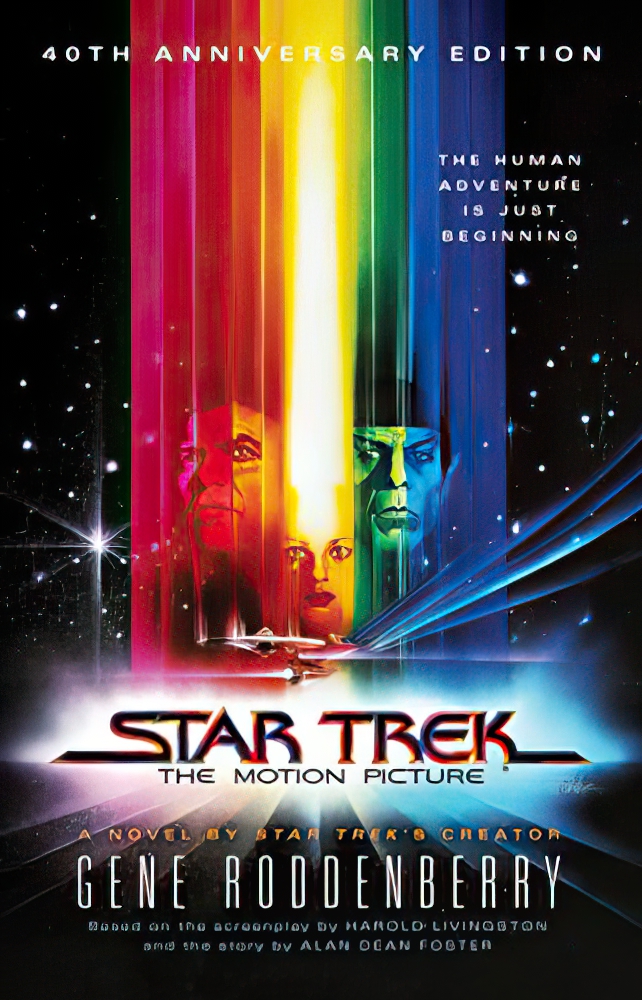 Story: As has been the case with all of the Star Trek movie and telelvision book adaptations since, Roddenberry embellishes the first movie’s storyline with a great deal of off-screen plotting which we didn’t see on film. Much of this backstory was itself embellished upon in the very brief Lost Years series of Trek novels published in the early 90s.
Story: As has been the case with all of the Star Trek movie and telelvision book adaptations since, Roddenberry embellishes the first movie’s storyline with a great deal of off-screen plotting which we didn’t see on film. Much of this backstory was itself embellished upon in the very brief Lost Years series of Trek novels published in the early 90s.
Review: Perhaps the most interesting elements that Star Trek’s creator introduced here were found between the lines, in footnotes and in the introduction attributed to Admiral Kirk himself. The introduction speaks of a new breed of human, a bland and conformist herd of sheep, from which Starfleet officers are different due to the “individuality” Starfleet affords them (which must make Starfleet the most unusual military service in the history of Earth!). This faceless majority of the population is described in terms that seem to paint them as only slightly more individual than the Borg. Of all the things about the Star Trek universe that Roddenberry altered in the development of the unmade 1970s Star Trek series – remember how we went from a Starfleet capable of producing unstable emotional wrecks like Ben Finney to a Starfleet which was happy and homogenous by the time of Next Generation? – I think the new human concept was one concept that was easy to drop, and I for one don’t miss it.
Many of Roddenberry’s co-workers have made note of the Great Bird of the Galaxy’s preoccupation with sex in their own books about the making of Star Trek, and though I don’t entirely disbelieve these accounts, I always keep in mind how easy it is to come up with such stories about those who are no longer present to defend themselves. But there’s plenty of evidence here that Gene spent a lot of time thinking with the other head. On one particular occasion, Roddenberry – in character as a 23rd century chronicler of the events described – almost breaks that character to address the existence of “K/S fiction,” a variety of homoerotic fan-written fiction depicting Kirk and Spock as lovers, which had arisen in the years between Star Trek’s TV death and its film rebirth. Roddenberry almost derails his own attempt to debunk the possibility of Kirk and Spock being gay by implying that Kirk may have experimented with bisexuality (!) – an unlikely trait given Kirk’s frequent conquest of women. Perhaps Gene was blurring the line between his own exploits and that of his character. (If so, that’s just a little bit more than I really wanted to know about either of them…) Roddenberry also spends a lot of time on the subject of Lt. Ilia and her race’s sexuality, which sometimes fills in the blanks that were left by the movie’s dialogue, but at other times seems to be there just for tittillation’s sake.
Once the Enterprise is on its way to its mission with V’ger (identified in this book, as was the case with the draft scripts and story treatments that appeared in Star Trek Phase II: The Lost Series, as “Vejur”), the novel pretty much sticks to the movie’s events in a straightforward manner. The only distraction from this point on is Roddenberry’s tendency to italicize phrases for no readily apparent reason. Most authors use this device to illuminate a character’s internal thoughts and dialogue, or to otherwise emphasize something of importance, but here it seems to happen almost entirely at random.
The novelization of Star Trek: The Motion Picture was perhaps the only time – with the exception, perhaps, of The Cage – that Gene Roddenberry was allowed to tell a Star Trek story without the constraints of television censors or budget …and, if for no other reason than that alone, I think it’s interesting, for it gives us our only first-hand glimpse of what Gene Roddenberry would have liked Star Trek to be.
Year: 1979
Author: Gene Roddenberry
Publisher: Pocket Books
Pages: 252 pages




